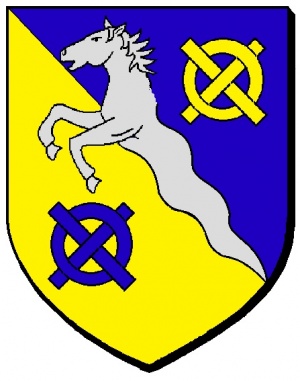Touillon-et-Loutelet
TOUILLON-ET-LOUTELET
Département : Doubs
| French | Tranché d'azur et d'or, à la demie jument cabrée combinée à une pile ondée posée en bande, d'argent, brochant sur la partition et accompagnée de deux annelets entravaillés avec deux bâtons alésés et passés en sautoir, de l'un en l'autre. |
| English | No blazon/translation known. Please click here to send your (heraldic !) blazon or translation |
Origin/meaning
The shield is divided into two parts to remind that the municipality consists of two villages: Touillon and Loutelet. Touillon is derived from an old word meaning swamp (hence blue), Loutelet is derived from L'Hospital, probably a small hostel (hence gold, from money) Touillon is located North of Loutelet, the two localities being separated by a busy road symbolised by the moving horse.
Lastly, gold refers to the gentian flowers from which a popular alcohol is extracted, and the azure water to the two fountains, the two streams, and the two ponds; as for the silver wave, it may also refer to milk production.
The half-mare rampant and ending in a wave, all silver, refers to a very original aspect of the intangible heritage of the town: the legend of the horse Gawain, which explains the local curiosity of the Round Fountain. It is said that the mare of Lord Amauri de Joux stopped at this fountain for a long drink. Feeling impatient of the time taken by his horse to quench his thirst, Amauri dismounted and then noted with astonishment that his horse had no rear end and that all the water he drank was spread on the ground through a giant injury. Ever since, it is said, the local fountain stops when the mare (now invisible) drinks and it resumes its flow when the animal stops drinking.
The two rings refer to the 'marriage' of the two villages, with the crosses taken from the arms of the Lords of Joux, to whom the villages historically belonged.
Literature: Image from http://www.armorialdefrance.fr
